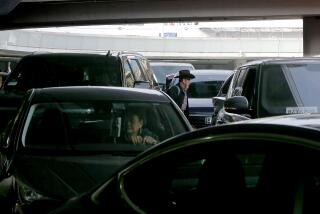L.A.’s traffic the worst in U.S., but Rio de Janeiro, Moscow the pits

Los Angeles has the worst traffic in the U.S., according to a report by TomTom, the GPS navigation device maker, and two more California cities make the top 10 list.
But take heart, Angelenos: Traffic here isn’t as bad as Moscow or Rio de Janeiro, one of the Brazilian cities where World Cup competitions will take place starting next Thursday.
The company’s 2013 Annual Traffic Index for American cities released Wednesday turned up interesting tidbits.
--If you think you’re spending more time sitting on the freeway, you are. L.A.’s traffic congestion level rated 36% last year, up 2% over 2012. The percentage means that, on average, a driver in Los Angeles takes 36% more travel time on an average trip compared with non-congested situations at the quietest times of day, a spokeswoman explained in an email.
--The average delay during peak hours was 39 minutes.
--The worst traffic day in 2013 was Nov. 14, when a Thursday evening (one of the busiest commute times during the week, TomTom says) collided with a big rig flip-over on the 60 Freeway.
Other U.S. cities that made the top 10 traffic list: San Francisco (32%), Honolulu (29%) Seattle (27%), San Jose (26%), New York City (26%), Miami (24%), Washington, D.C. (24%), Portland, Ore. (22%), and New Orleans (22%).
How does L.A. measure up on the global scale? Thankfully, its car-crushing culture drops to No. 4.
Rio de Janeiro, one of the FIFA World Cup host cities, has the worst traffic in the Americas, followed by Mexico City and Sao Paulo, Brazil. Vancouver, Canada, came in fifth, with traffic congestion times similar to L.A.
For those traveling abroad who plan to rent a car, know that Moscow had a whopping 75% congestion rate in 2013, followed by Istanbul, Turkey (62%); Palermo, Italy (39%); Warsaw (39%); Rome (37%); Dublin, Ireland (35%); Marseille, France (35%); Paris (35%); London (34%) and Athens (34%).
TomTom measures travel times during the whole day and during peak periods and compares them with measured travel times during non-congested periods. The difference is expressed as a total average percentage increase in travel time, the company’s report says.
Traffic reports city by city in the Americas, Europe, Australia and New Zealand and South Africa can be found at TomTom’s website.
More to Read
Sign up for The Wild
We’ll help you find the best places to hike, bike and run, as well as the perfect silent spots for meditation and yoga.
You may occasionally receive promotional content from the Los Angeles Times.







